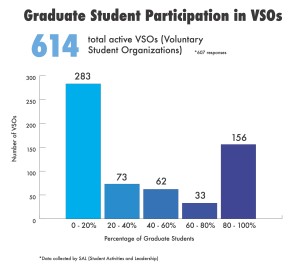
Of the 614 active student groups on campus that are formally recognized as voluntary student organizations (VSOs), 66 are exclusive to graduate students. In both graduate-only and mixed undergraduate-and-graduate groups, graduate students often have different experiences than undergraduates when it comes to student organizations.
“I think that grad students have slightly different experiences and slightly different needs,” said Kate Bridges-Lyman, a 2nd year master’s student in religious studies, who has been involved with Islamic Society of Stanford (ISSU) and is now the vice president.
Living off-campus and being unable to find a humanities-focused student organization on campus, Bridges-Lyman found it hard to become part of a VSO at first, but she ended up finding a good community within ISSU.
Several graduate students expressed having felt out of place upon seeing that many student organizations at Stanford by and large consisted of undergraduates.
“When I first came to Stanford, I found it very awkward being involved as a grad student,” said Irene Kaplow, a fifth-year Ph.D. student in computer science. “It was very weird for me to go to events and feel like I was one of two or three grad students in a room of 50 people. I felt very out of place.”
For Kaplow, Women in Computer Science (WiCS) was one of the few organizations where she felt like she did belong. She joined WiCS and is now working as the graduate representative of the organization.
Kevin McCabe, a second-year master’s student in energy resources engineering, agreed that it can be difficult for graduate students to connect with undergraduates in student organizations. According to McCabe, this is a greater overall trend.
“The predominant feeling of graduate students is just to sort of avoid the undergraduate organizations and undergraduates in general. There is kind of a disconnect between the two, which is kind of natural because graduate students don’t really experience the same things that undergrads do,” said McCabe.
Having been an undergraduate at Stanford, McCabe considers himself lucky to already have connections from his undergraduate years. For example, McCabe was able to continue being involved with the Asia-Pacific Student Entrepreneurship Society (ASES) as the group’s financial officer in his graduate years.
However, not all graduate students feel the divide as strongly. Joseph Katz, a 3rd year Ph.D. student in electrical engineering, and Savannah Goodman, a first-year master’s student in the Atmosphere Energy Program, who are both involved with Engineers for a Sustainable World (ESW), did not agree that there is a definite rift between the two communities of students but simply certain differences.
“I think undergrads are here [in ESW] for exploration and grad students already know that [they] want to work on this sort of thing. So we are just looking for an outlet to do it as opposed to just decide if we want to do it,” said Katz.
While Bridges-Lyman pointed out the age difference as part of the reason of the disconnect, McCabe felt there are certain stereotypes undergraduates might intentionally or unintentionally hold against graduate students.
“There is a culture of being very separate [with] the two communities… Undergrads calling grad students ‘creepy grad students’[…] is so intoned into the two communities,” said McCabe. “If it’s true or not, it’s sort of created a rift regardless.”
In contrast, Hans Banerjee, a first-year master’s student in electrical engineering who is part of ESW, believes there is always a way to make the bridge between the two groups of students especially through student organizations.
“I feel that everyone in the Stanford community shares certain ideals, a certain intellectual caliber. Because of that, I feel like everyone is really easy to talk to and very approachable,” said Banerjee.
According to Bridges-Lyman, part of the problem is that VSOs at Stanford do not have a club model where the whole community comes together at weekly gatherings, which makes it difficult for graduates to interact with undergraduates. Bridges-Lyman also felt that the decentralized nature of the campus, with undergraduate and graduate housing being somewhat scattered, adds to the lack of connection between undergrads and grads.
“The responsibility is kind of on some student organizations to reach out to graduate students, and make sure they’re marketing to [graduate students] as well,” said Banerjee.
Contact Sevde Kaldiroglu at sevde ‘at’ stanford.edu.